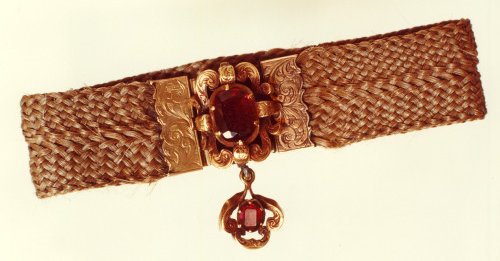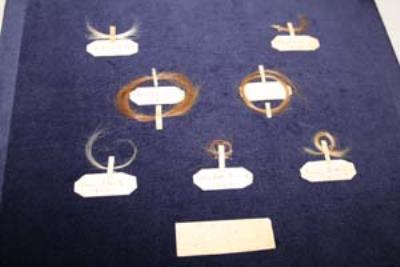


Description:
Mourning is not always pertaining to death. And although the Bronte sisters, most notably Charlotte Bronte had seen both of her beloved sisters and brother die, she was able to carry with them more than subjective recreations of those she was mourning. She held dear to her, and wore everyday a woven bracelet that was made of both of her deceased sisters hair. Notably not Branwell, due to his complicated and troubled relationship to his family members. Hair jewelry was extremely popular in the Victorian era due to the inaccesability of images of the deceased. In this way, lockets of ones hair were able to be taken post mortem and treasured as a relic. Charlotte was able to bring with her everyday, the sentiment of her sisters being near. The hair bracelet is now kept in the Bronte Parsonage Museum, along with the second picture, in which hair from the Bronte family has been collected and taken care of. The second two pictures relate to Branwell Bronte, and his mourning, of both his physical self, and the mourning of his failed potential and difficult life.
Chalotte Bronte's Hair Bracelet Located in the Bronte Parsonage Museum
This bracelet is made of the hair of Charlotte Bronte's deceased sisters Emily and Anne. Emily and Anne both died in a similar time span, Anne dying in 1848 while Emily had passed away in 1849. Charlotte outlived her two sistesr by 6 and 7 years respectively, and was very impacted by the loss of her sisters. Growing up the sisters had to deal with a large amount of loss in their life, and this tragedy forged a deep connection between the three. Although this loss was great for Charlotte, she was able to find some reprise in the creation of her hair bracelt. Although to a 20th century viewer this tradition might seem strange, in the Victorian era it was quite normalised. This was due to the inaccesability to portraits and paintings. Most non-upperclass Victorian people would not have the means to have a portrait commissioned, and so the only memory most Victorians had was hair. For this reason relic culture began to amass popularity and hair was kept post mortem in order to stay connected to the deceased.
A Collection of Hair of the Bronte's Located in the Bronte Parsonage Museum
Similarly to the previous image, hair was quite important to those living in the Victorian era, and to most represented something more than the hair itself. It would embody the spirit of the person to which it was previously attached. An attachment which is then transferred to whoever now holds the hair. This image is a collection of the quite brittle and fragile hair of the Bronte sisters which was collected and preserved. It is quite notable that the Bronte sisters did not have red hair which is a common misconception. Due to their Irish descent and older brother Branwell having red hair many though that the sisters indeed were red headed themselves. These lockets of hair represent the Bronte sisters, and at the time would have been thought to be quite powerful. Their message was transformed with age, and now exists as a strangely unique, but personal part of one of the greatest literary dynasties.
Branwell Bronte Self-Caricature of him Dying
This image is quite interesting as it is depicting Branwell Bronte on his deathbead. There appears a skeleton figure hovering over him, with movement suggested towards Branwell. This would imply that death is coming for Branwell, and him to bedridden to defend himself can do nothing to stop it. What is most notable about this drawing is that it is a self-caricature of himself, representing how he viewed himself or wanted to present himself to the world in his final moments. Branwell's crossbody position, creates a sense of weakness in him. His body nearly parellels the fetal position which shows how powerless in this moment he is. This may have been due to the powerlessness he felt towards death. Expressing death as a figure moving towards him shows how little agency Branwell felt that he had when it came to his mortality. He was not ready for death, possibly due to his unfulfilled potential which haunted him through his entire life.
The Bronte Sisters (circa 1834)
This is one of the most iconic paintings of the Bronte sisters. It was painted by Branwell Bronte himself and had originally contained all four of the Bronte children. However Branwell would eventually come to paint himself over and put a pillar over the entirety of himself. This decision is very representative of Branwells life in general. He was a trouble maker who struggled with his own demons. He was quite problematic and had very toxic tendancies that he grew into early in life. He had exceptional talent during his youth but was never able to live up to it. His sisters quickly outgrew him in popularity, and he was left behind. These feelings of inadequacy may have caused Branwell to paint himself out of the painting. It is a poignant reference to how awry he went in life, and although this is not directly related to mourning in the life and death manner, he is mourning the loss of his talent. His aspirations of being a painter and poet quickly died as represented in his removal from the painting.
